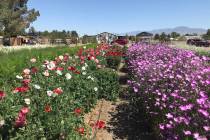Death Valley sees hottest June on record
DEATH VALLEY N.P. When an area sees record-breaking heat numbers it usually catches ones eye, but when the place setting records is the hottest place on Earth thats a whole other story.
Death Valley National Park saw its hottest June on record last month with an average temperature of 101.9 degrees.
The record number is about six degrees above normal for the month, as the average temperature over the past 105 years was 95.5 degrees, at the official weather observation spot, Furnace Creek.
With the early onslaught of sweltering heat, Death Valley officials are concerned with what temperature the area could see next.
Were not even in the hottest part of the summer yet, said Mike Reynolds, Death Valley superintendent. Who knows what July and August will bring.
Reynolds also cautioned that just because night falls, that temperatures still can be in the triple-digit range.
The average temperature sounds hot enough, but when you break it down, you can really understand the extreme summer conditions in Death Valley. People expect a desert to cool down at night, but the night of June 21st only cooled down to 101 °F, he said.
Death Valley holds the record for the highest officially recorded temperature on the planet of 134 degrees, which occurred on July 10, 1913.
Death Valley reaches a high of at least 90 degrees an average of 190 days per year, a daily high of 100 degrees about 140 days a year, 110 degrees 89 days per year and above 120 degrees around eight days a year on average.
Showing just how sweltering the heat has been this year, Death Valley has already seen eight 120-degree days, meeting the yearly average, with most of July and August left to send the mercury soaring on the thermometer.
Despite the impressive heat numbers, visitors still flock to the national park in the hot summer months.
Death Valley National Park receives more summer visitation than you might expect. August is the parks third busiest month, behind only March and April, Reynolds said. Many of these visitors are from other countries and they come here to experience our world-famous extreme temperatures. I respect those visitors. Think about it … summer is the time to experience the thing that makes Death Valley different from any other place on Earth.
Being informed is key to those who want to experience the extreme heat Death Valley sees and remain safe, according to Reynolds.
We advise park visitors to drive on paved roads and not to walk very far in the summer. Cell phones dont work in most of the park, and being stranded in high temperatures can quickly turn life-threatening, he said. A few weeks ago a German motorcycle rider died on the unpaved Harry Wade Road. If he had been on a well-traveled road, other park visitors would have seen him and taken him into their car to cool off. That probably would have saved his life.
Other travel tips include: wearing a hat, light-colored loose-fitting clothing, and to drink plenty of water. Humidity in Death Valley is usually very low, often below 10 percent.
People dont realize how much theyre sweating, Reynolds said. Bring at least one gallon of water per person per day – and drink it.
Visitors come to see sites at various elevations in the park, including low elevation sites like Badwater (282 feet below sea level), and hikes to Wildrose Peak (elevation 9,064 feet) and Telescope Peak (elevation 11,049 feet) which are best carried out in warmer months when they are not covered in snow.
With the high overnight temperatures, sleeping at Furnace Creek Campground can be unbearable for most people in summer, but temperatures at Wildrose Campground (elevation 4,100 feet) and Mahogany Flat Campground (elevation 8,200 feet) are lower and make camping overnight more comfortable.
Death Valleys average daily high temperature this June was 115.5 degrees and the average overnight low was 88.2 degrees.
Despite the record-setting average temperature for the month of June, Death Valley only set one daily high temperature record last month, with the 126-degree high temperature recorded on June 21, 2016.
The highest temperature ever recorded in Death Valley in June occurred on June 30, 2013 with a 129-degree high temperature.
Information about Death Valleys climate history is available online at www.wrh.noaa.gov/vef/climate/DeathValleyClimateBook/.
Contact reporter Mick Akers at makers@pvtimes.com. Follow @mickakers on Twitter.





















